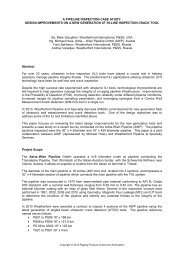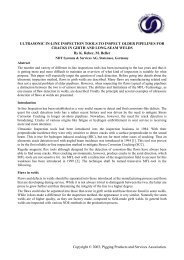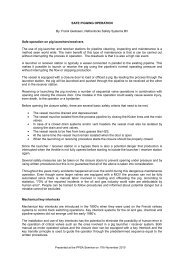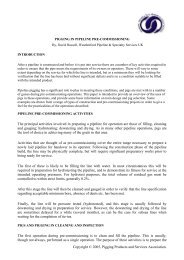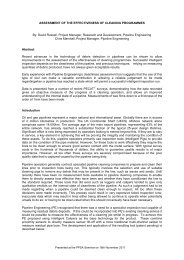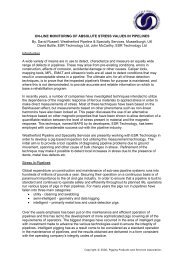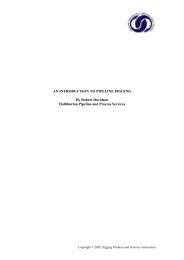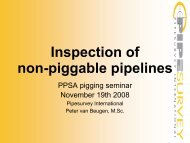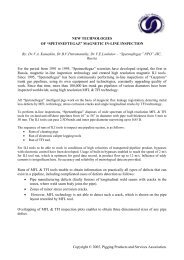Acoustic Reflectometry for Gas Pipelines – Monitoring Features in ...
Acoustic Reflectometry for Gas Pipelines – Monitoring Features in ...
Acoustic Reflectometry for Gas Pipelines – Monitoring Features in ...
You also want an ePaper? Increase the reach of your titles
YUMPU automatically turns print PDFs into web optimized ePapers that Google loves.
Flexible riser pipe is hence a challenge to the <strong>in</strong>spection service <strong>in</strong>dustry and several jo<strong>in</strong>t <strong>in</strong>dustry<br />
projects have been launched to tackle this problem [1, 2 and 4]. The multi-layered structure of the<br />
flexible riser pipe presents a problem <strong>for</strong> most of the typical NDT-Technologies employed <strong>in</strong> regular<br />
steel pipe. While Ultrasonic based technologies often have the advantage of yield<strong>in</strong>g <strong>in</strong><strong>for</strong>mation also<br />
from non-metallic material, the coupl<strong>in</strong>g between different layers often prevents a complete picture.<br />
Electromagnetic methods, <strong>in</strong> contrast, will select conductive material, while other material, like<br />
polymers will not be considered. The subject rema<strong>in</strong>s an area of active research, but solutions<br />
target<strong>in</strong>g specific concerns are now available.<br />
Defects <strong>in</strong> flexible riser pipe<br />
The flaws and defects that flexible riser pipe may suffer from are quite manifold. As a matter of fact<br />
rais<strong>in</strong>g the issue with different operators it is likely that the mentioned issues will differ widely.<br />
However, a few ma<strong>in</strong> concerns have risen. In particular as the lifetime of flexible riser pipe is deemed<br />
to be governed by fatigue-life, fatigue related defects are expected. While macroscopically fatigue will<br />
result <strong>in</strong> a reduced material strength, microscopically it will be the emergence of cracks that constitute<br />
a possible route to failure. With the armoured layers designed to take the ma<strong>in</strong> part of the bend<strong>in</strong>g<br />
stresses, this layer would be most prone to crack<strong>in</strong>g.<br />
In addition <strong>in</strong>evitable damages <strong>in</strong> the outer sheath will lead to the <strong>in</strong>gress of water. This can cause<br />
corrosion <strong>in</strong> the outer layers of the tensile armour. F<strong>in</strong>ally any overbend<strong>in</strong>g of the pipe can lead to an<br />
unlock<strong>in</strong>g of the pressure armour or to fatigue crack<strong>in</strong>g <strong>in</strong> the clamp<strong>in</strong>g parts of the pressure armour.<br />
Further defects like erosion have been reported.<br />
Pigg<strong>in</strong>g flexible riser pipe<br />
As mentioned previously the uneven <strong>in</strong>ner surface of a carcass does not render flexible pipe<br />
unpiggable. Intelligent pigs have passed through flexible pipe many times. No major problem has been<br />
reported. Concern<strong>in</strong>g defect detection, the <strong>in</strong>spection is very much limited to the <strong>in</strong>side, i.e. the<br />
carcass. Distortions and changes <strong>in</strong> the structure, unlock<strong>in</strong>g etc. usually become visible <strong>in</strong> such<br />
surveys. However, MFL as well as UT-based <strong>in</strong>telligent pigs have a limitation <strong>in</strong> penetrat<strong>in</strong>g further<br />
<strong>in</strong>to the pipe. In pr<strong>in</strong>ciple MFL could still detect larger defects <strong>in</strong> the <strong>in</strong>ner layers, but the resolution<br />
would be reduced. Precaution shall be taken when us<strong>in</strong>g MFL-tools with carbon steel brushes <strong>in</strong><br />
sta<strong>in</strong>less steel carcasses. A metallurgical <strong>in</strong>vestigation is required to avoid “after-rust”.<br />
Figure 2: View of a flexible riser pipe by a UT Wall thickness tool. Courtesy of NDT Systems &<br />
Services AG us<strong>in</strong>g L<strong>in</strong>eExplorer UM<br />
Prior technologies<br />
One of the most often applied techniques is radiography [1, 3]. While this technique shows high<br />
resolution images, the ease of deployment is somewhat limited. It may turn out to be an excellent<br />
verification technique. Another electromagnetic technology is MAPS [4]. This technology is currently <strong>in</strong><br />
Presented at the PPSA Sem<strong>in</strong>ar on 16 th November 2011



